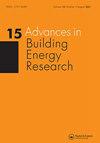Experimental and energy saving potential analysis of GSHP and ASAC systems using normalized sensitivity technique in cooling mode operation
IF 2.5
Q2 CONSTRUCTION & BUILDING TECHNOLOGY
引用次数: 0
Abstract
ABSTRACTThe current investigation examines the experimental and energy-conservation analyses of 17.5 kW cooling capacity of a ground-source heat pump (GSHP) system and an air-source air-conditioning system (ASAC) of the same cooling capacity. Using experimental data and a sensitivity technique, the thermal efficiency of both the systems were evaluated. During the experiments conducted for cooling period in June 2022, the data for six-day operation were collected and the coefficient of performance of both the systems were evaluated. Notably, the GSHP system exhibited an average cooling capacity of 10 to 15 kW, whereas the ASAC maintained a range of 9 and 13 kW. The coefficient of performance (COP) for the GSHP system was obtained as 3.8, while the ASAC system COP was 2.9. The results indicate that the use of GSHP system results in an energy-saving of 10–40% in comparison to the ASAC system. Moreover, the present study included uncertainty and propagation analyses, along with sensitivity evaluations, with the objective of identifying the most influencing parameter on the derived parameters. Sensitivity analysis indicates outlet temperature of air from the evaporator is the most influencing parameter for the performance of both the systems.KEYWORDS: Ground-source heat pumpair-source air-conditioning systemenergy-savingsuncertainty and sensitivity analysiscooling mode operation AcknowledgementsThe experimental facilities for this research were provided by the Department of Architecture and Planning at IIT Roorkee supported by the Engineering and Physics Science Research Council (EPSRC) of the United Kingdom (EP/R00861) and the Government of India (ZED-i). The author would like to express gratitude for the assistantship provided by the Ministry of Human Resources and Development, India, as well as the National Institute of Hydrology in Roorkee for supplying the weather data necessary for this research project.Credit authorship contributionShammy Kumar Sah: Data interpretation, Writing-manuscript, Writing-review and editing, Numerical analysis, Methodology, Validation. Krishnan Murugesan: Supervision, Writing-review and editing. Elangovan Rajasekar: Supervision, Writing-review and editing.Disclosure statementNo potential conflict of interest was reported by the author(s).用归一化灵敏度技术分析地源热泵和ASAC系统在冷却模式下的实验和节能潜力
摘要本研究对具有相同制冷量的地源热泵(GSHP)系统和空气源空调系统(ASAC)的17.5 kW制冷量进行了实验和节能分析。利用实验数据和灵敏度技术,对两种系统的热效率进行了评估。在2022年6月进行的冷却期实验中,收集了6天的运行数据,并对两个系统的性能系数进行了评估。值得注意的是,地源热泵系统显示出10至15千瓦的平均冷却能力,而ASAC保持在9至13千瓦的范围内。GSHP系统的性能系数(COP)为3.8,ASAC系统的COP为2.9。结果表明,与ASAC系统相比,使用地源热泵系统节能10-40%。此外,本研究包括不确定性和传播分析,以及敏感性评估,目的是确定对导出参数影响最大的参数。灵敏度分析表明,蒸发器出风口温度是影响两种系统性能的最大参数。关键词:地源热泵-空气源空调系统节能太阳确定性和灵敏度分析冷却模式运行致谢本研究的实验设备由英国工程与物理科学研究委员会(EPSRC) (EP/R00861)和印度政府(ZED-i)支持的印度理工学院建筑与规划系提供。作者谨对印度人力资源和发展部提供的援助以及位于鲁尔基的国家水文研究所为本研究项目提供必要的天气数据表示感谢。shammy Kumar Sah:数据解释,写作-手稿,写作-审查和编辑,数值分析,方法,验证。Krishnan Murugesan:监督,写作,审查和编辑。Elangovan Rajasekar:监督,写作,审查和编辑。披露声明作者未报告潜在的利益冲突。
本文章由计算机程序翻译,如有差异,请以英文原文为准。
求助全文
约1分钟内获得全文
求助全文
来源期刊

Advances in Building Energy Research
CONSTRUCTION & BUILDING TECHNOLOGY-
CiteScore
4.80
自引率
5.00%
发文量
11
 求助内容:
求助内容: 应助结果提醒方式:
应助结果提醒方式:


